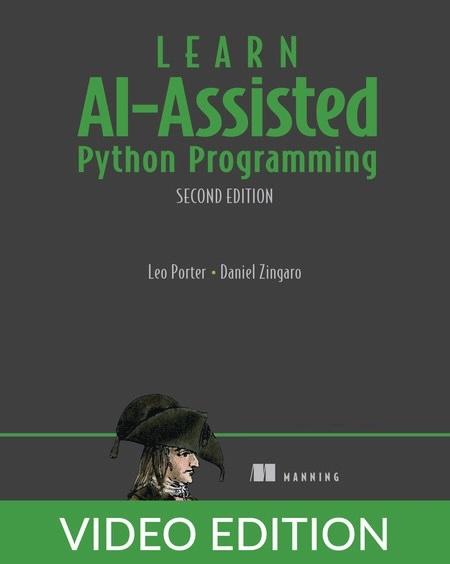English | MP4 | AVC 1280×720 | AAC 44KHz 2ch | 9h 2m | 1.42 GB
See how an AI assistant can bring your ideas to life immediately!
Once, to be a programmer you had to write every line of code yourself. Now tools like GitHub Copilot can instantly generate working programs based on your description in plain English. An instant bestseller, Learn AI-Assisted Python Programming has taught thousands of aspiring programmers how to write Python the easy way—with the help of AI. It’s perfect for beginners, or anyone who’s struggled with the steep learning curve of traditional programming.
In Learn AI-Assisted Python Programming, Second Edition you’ll learn how to:
- Write fun and useful Python applications—no programming experience required!
- Use the GitHub Copilot AI coding assistant to create Python programs
- Write prompts that tell Copilot exactly what to do
- Read Python code and understand what it does
- Test your programs to make sure they work the way you want them to
- Fix code with prompt engineering or human tweaks
- Apply Python creatively to help out on the job
AI moves fast, and so the new edition of Learn AI-Assisted Python Programming, Second Edition is fully updated to take advantage of the latest models and AI coding tools. Written by two esteemed computer science university professors, it teaches you everything you need to start programming Python in an AI-first world. You’ll learn skills you can use to create working apps for data analysis, automating tedious tasks, and even video games. Plus, in this new edition, you’ll find groundbreaking techniques for breaking down big software projects into smaller tasks AI can easily achieve.
The way people write computer programs has changed forever. Using GitHub Copilot, you describe in plain English what you want your program to do, and the AI generates it instantly.
This book shows you how to create and improve Python programs using AI—even if you’ve never written a line of computer code before. Spend less time on the slow, low-level programming details and instead learn how an AI assistant can bring your ideas to life immediately. As you go, you’ll even learn enough of the Python language to understand and improve what your AI assistant creates.
What’s inside
- Prompts for working code
- Tweak code manually and with AI help
- AI-test your programs
- Let AI handle tedious details
Table of Contents
1 About the technology
2 How Copilot changes how we learn to program
3 Introducing AI-assisted programming with GitHub Copilot
4 Risks and challenges when using Copilot
5 Societal concerns about AI code assistants like Copilot
6 Summary
7 The skills we need
8 What else can Copilot do for us
9 Addressing common Copilot challenges
10 Getting started with Copilot
11 Getting your system set up Part 1
12 Getting your system set up Part 2
13 Our path forward
14 Summary
15 The software we ll be using
16 Working with Python in Visual Studio Code
17 Writing and running some small programs
18 Benefits of functions
19 Designing functions
20 Examples of creating good functions with Copilot
21 Exercises
22 Roles of functions
23 Summary
24 The design cycle of functions with Copilot
25 What s a reasonable task for a function
26 Asking Copilot to explain code
27 Exercises
28 Reading Python code Part 1
29 Summary
30 Top 10 programming features you need to know Part 1
31 Exercises
32 Reading Python code Part 2
33 Summary
34 Another full testing example Testing with files
35 Closed-box and open-box testing
36 Exercises
37 Full testing example
38 How to test your code
39 Revisiting the cycle of designing functions with Copilot
40 Summary
41 Testing and prompt engineering
42 Breaking down the process subproblem
43 Exercises
44 Implementing our functions
45 Problem decomposition
46 Small examples of top-down design
47 Spelling suggestions
48 Spelling suggestions using top-down design
49 Summary
50 Summary of our top-down design
51 A caution about debugging
52 Applying our debugging skills to a new problem
53 Debugging and better understanding your code
54 Exercises
55 How to find the bug
56 How to fix a bug (once found)
57 Modifying our workflow in light of our new skills
58 Summary
59 Using the debugger to better understand code
60 Automating tedious tasks
61 Example 1 Cleaning up email text
62 Example 2 Adding cover pages to PDF files
63 Example 3 Merging phone picture libraries
64 Exercises
65 How to use Copilot to write tools
66 Summary
67 Adding randomness
68 Example 1 Bulls and Cows
69 Example 2 Bogart
70 Exercises
71 Making some games
72 Summary
73 Authorship identification using top-down design
74 Breaking down the process subproblem
75 Creating an authorship identification program
76 Exercises
77 Going further
78 Implementing our functions
79 Summary
80 Summary of our top-down design
81 Exercises
82 Future directions
83 Limitations and future directions
84 Summary
Resolve the captcha to access the links!
